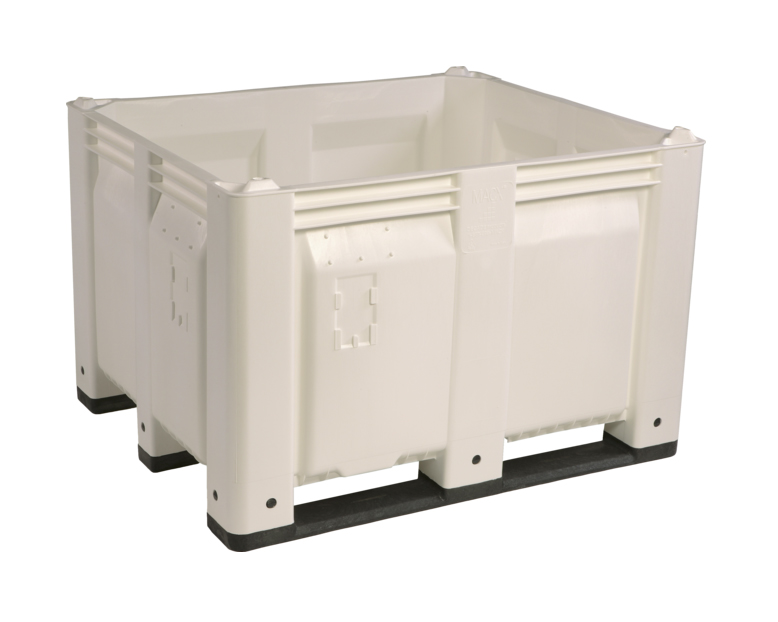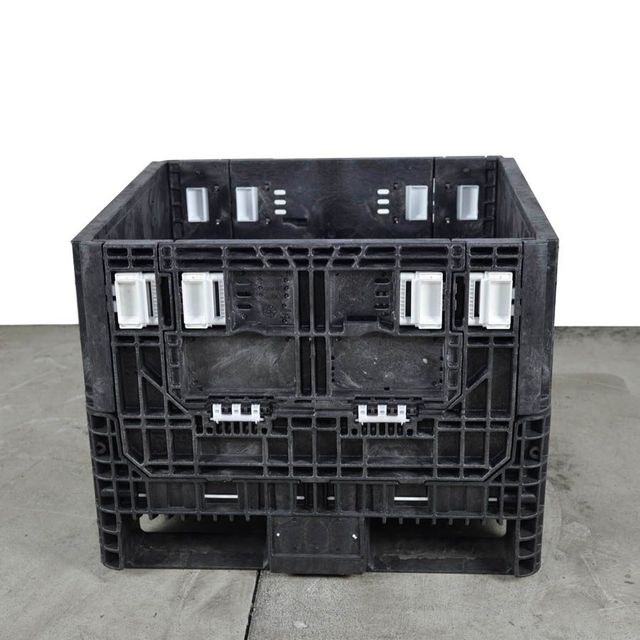Discover durable solutions with used plastic containers for safe storage
Wiki Article
The Ultimate Guide to Picking the Right Mass Containers for Your Organization Requirements
Choosing the ideal mass containers is important for any company that counts on effective logistics. Different kinds of containers exist, each designed for specific materials and applications. Variables such as dimension, material compatibility, and regulative criteria play a considerable function in this decision-making process. Recognizing these components can cause enhanced operational performance. Nonetheless, several services forget crucial facets that can boost their total efficiency and sustainability. What are these considerations?Comprehending Various Kinds Of Bulk Containers
Mass containers act as crucial tools for organizations looking for efficient storage and transportation services. These containers can be found in different kinds, each designed to meet certain functional needs. One common type is the intermediate mass container (IBC), which is suitable for fluid and granulated products, using a balance of capacity and maneuverability. One more preferred alternative is the bulk bag, or FIBC, suitable for completely dry, flowable products. These versatile containers are light-weight and can be easily moved and kept. For heavier materials, rigid mass containers are commonly used, providing resilience and stability for secure handling. In addition, there are customized containers customized for dangerous materials, guaranteeing conformity with safety regulations. Understanding the distinct qualities of these mass container types enables organizations to make enlightened decisions that maximize logistics and lower expenses. By choosing the right container, business can boost their operational effectiveness and streamline their supply chain procedures.Trick Material Factors To Consider for Mass Containers
When picking bulk containers, it is necessary to consider the materials made use of in their construction. Elements such as chemical, resilience, and strength compatibility play a vital role in making certain the containers fulfill specific operational needs. Furthermore, weight and transportability worries can influence both efficiency and transport logistics.Material Toughness and Stamina
Longevity and stamina are crucial consider selecting materials for bulk containers, as they directly influence the container's capability to withstand different ecological conditions and dealing with processes. Materials such as high-density polyethylene (HDPE), polypropylene, and stainless steel are frequently preferred for their durable homes, supplying resistance to impact, temperature level, and abrasion changes. The choice of material likewise affects the overall life expectancy of the container; more powerful products usually cause much less frequent replacements, leading to set you back savings over time. Additionally, the weight of the product can influence delivery prices and simplicity of handling. Services must consider their particular operational environments and the possibility for deterioration to guarantee peak toughness and stamina in their mass container choice.Chemical Compatibility Variables
Comprehending chemical compatibility is essential for picking mass containers, as the materials used must withstand the details compounds they will hold. Different factors influence compatibility, consisting of the chemical nature of the materials, temperature level, and duration of storage space. Destructive chemicals might call for containers made from stainless steel or specialized plastics that stand up to destruction. Additionally, reactive substances can generate warmth or gases, demanding vented or pressure-rated containers. The choice of container material, whether polyethylene, steel, or polycarbonate, need to straighten with the chemical homes of the stored substances to avoid leakages or violations. Eventually, an extensive analysis of these compatibility factors guarantees safe handling and storage space, securing both employees and the atmosphere while keeping product integrity.Weight and Mobility Concerns
Selecting mass containers includes not only reviewing chemical compatibility however additionally considering weight and transportability. Companies need to assess the simplicity of handling and transportation to maximize efficiency. Lightweight materials like high-density polyethylene (HDPE) or light weight aluminum can promote simpler motion and lower delivery prices. Alternatively, much heavier containers might offer boosted durability yet can impede flexibility, especially in environments requiring constant moving. In addition, the style of the container must enable for practical training and stacking, guaranteeing ergonomic security for employees. Firms must additionally take into consideration the infrastructure offered for transportation; for instance, containers compatible with forklifts or pallet jacks can enhance procedures. Ultimately, the ideal equilibrium between weight and portability directly influences functional performance and price performance.Sizing Your Bulk Containers for Ideal Performance
When sizing mass containers, companies must carefully examine the measurements required to accommodate their details items. In addition, weight ability is an essential aspect that affects efficiency and security throughout transport and storage space. Reliable sizing not just maximizes space but also optimizes operational workflows.Identifying Container Dimensions
Choosing the appropriate measurements for bulk containers is important for maximizing performance in storage space and transportation. Businesses have to examine their particular needs, considering variables such as offered area, the nature of the goods being saved, and the methods of transportation utilized. Accurate measurements guarantee that containers fit ideally in stockrooms and vehicles, decreasing wasted area and minimizing managing time. Standard sizes can offer comfort, but personalized measurements could be essential for distinct needs or to fit details products. Furthermore, it is necessary to examine stacking capacities and availability, as these variables influence total operational performance. Eventually, the best dimensions bring about boosted organization and streamlined logistics, benefiting the general performance of business.Weight Ability Considerations
Understanding weight ability is important for businesses intending to enhance their mass container performance. The weight ability of a container directly impacts storage space capabilities, transportation logistics, and overall functional prices. Choosing containers with the proper weight limits guarantees that go to the website services can securely save and transfer their products without risking damages or conformity concerns. Straining containers can cause structural failures, while underutilizing capability lead to squandered resources. When selecting containers, it is vital for organizations to analyze their product weights and consider any regulative needs. Additionally, aspects such as the sort of product, intended use, and environmental problems should also influence weight ability choices. By assessing these elements, companies can boost effectiveness and assure a streamlined supply chain.Governing Compliance and Safety Specifications

Regulative conformity and safety criteria play a vital role in the option of bulk containers for services. Organizations must ensure that their containers fulfill numerous regulations set by neighborhood, national, and worldwide authorities. These standards usually relate to material safety, structural integrity, and appropriate labeling, which help stop mishaps and assure the safe transport of products.
Additionally, adherence to industry-specific guidelines, such as those from the Food and Medicine Management (FDA) or the Occupational Safety And Security and Health Administration (OSHA), is crucial for business taking care of hazardous materials or food products. Non-compliance can lead to penalties, lawful issues, or damage to an organization's credibility.
Services must additionally consider the container's compatibility with the materials being kept or delivered to stay clear of contamination or chemical reactions (refurbished bulk containers). To summarize, comprehending and carrying out regulative conformity and safety standards is vital for the responsible and effective use mass containers
Sustainability Options for Eco-Friendly Bulk Containers

Business are additionally checking out choices made from recycled materials, which not only preserve sources yet additionally support the reusing market. Innovations in layout allow for lighter containers that call for much less energy to transport, additionally improving sustainability. By integrating these green bulk container options, companies can demonstrate their dedication to environmental stewardship while satisfying consumer need for lasting practices. This change not just helps the world but can also boost brand name online reputation and customer commitment.
Cost-Effectiveness and Budgeting for Mass Containers
While lots of businesses concentrate on sustainability, cost-effectiveness remains a crucial factor when choosing mass containers. Organizations has to assess the initial acquisition rate, along with long-term functional costs, to assure economic stability. Factors such as reusability, sturdiness, and maintenance play a significant function in figuring out total costs.Buying top quality containers might generate greater upfront expenses yet can lead to savings with decreased replacement prices and decreased waste. Additionally, organizations need to consider transportation expenses and storage space efficiency, as these can affect this content the overall budget.

Frequently Asked Questions
Exactly how Do I Determine the Right Container for Hazardous Materials?
To figure out the appropriate container for harmful products, one must assess compatibility with the material, consider the container's material, check for regulatory compliance, and analyze capability and security attributes to assure correct handling and storage.Can Bulk Containers Be Personalized for Certain Products?
Yes, bulk containers can be customized for certain items. used plastic containers. Numerous functions, such as design, size, and material, can be tailored to fulfill unique needs, making certain excellent security and effectiveness for moving and saving different productsWhat Is the Typical Life-span of Different Mass Container Kind?
The average lifespan of mass container kinds varies; plastic containers last 5-10 years, steel containers 10-20 years, and wood containers usually last 3-7 years, depending upon usage, upkeep, and ecological problems.How Should I Clean and Maintain Bulk Containers?
To clean and maintain bulk containers, one ought to regularly check for damages, get rid of residue, wash with appropriate cleaning agents, wash completely, and assurance proper drying out prior to storage. Following manufacturer standards improves long life and safety throughout usage.hop over to these guys
Exist Rental Options for Bulk Containers Available?
Yes, numerous companies offer rental choices for mass containers, giving flexibility for organizations. These services can suit numerous requirements, permitting business to take care of inventory successfully without the dedication of acquiring containers outright.Durability and stamina are crucial elements in choosing products for mass containers, as they straight influence the container's capability to withstand numerous ecological conditions and managing processes. Comprehending chemical compatibility is vital for picking bulk containers, as the materials made use of should stand up to the certain materials they will hold. Comprehending weight capacity is essential for companies intending to enhance their mass container effectiveness. Governing conformity and safety and security standards play an essential duty in the selection of mass containers for companies. While numerous organizations focus on sustainability, cost-effectiveness stays an important factor when choosing bulk containers.
Report this wiki page